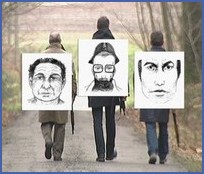| | | Vague d'attentats au Luxembourg |  |
|
+19pami75 Cheshire cat alain titu Robert du Bois Et In Arcadia Ego Hoho xyu spielmann max789 White Crow kowalski Henry dim michel VictoryII dislairelucien HERVE K 23 participants | |
| Auteur | Message |
|---|
HERVE
Nombre de messages : 21423
Date d'inscription : 08/12/2009
 |  Sujet: Re: Vague d'attentats au Luxembourg Sujet: Re: Vague d'attentats au Luxembourg  Jeu 27 Fév 2014 - 16:13 Jeu 27 Fév 2014 - 16:13 | |
|
En février 2008, le Grand-Duc s’est vu décerner le Bailli Grand-Croix d’Honneur et de Dévotion de l’Ordre de Malte.
A noter (dans les années 1980) :
Mme Raymond Barre "Grand Cross of Merit"
Antoine Pinay "Grand Cross of Merit"
Valéry Giscard d'Estaing "Bailli grand-croix d'honneur et de dévotion de l'ordre souverain de Malte"
... ce qui nous conduit notamment au cercle Pinay (-Violet) et aux avions renifleurs.
Une autre personnalité :
http://www.inmemoriam.be/nl/2013-07-27/yves-jean-du-monceau-de-bergendal/#.Uw9fPIXIeJI
Grand-Croix de Grâce Magistrale de l'Ordre Souverain de Malte
... sans oublier Jean-François Etienne des Rosaies.
Ci-dessous, un intéressant article sur l'ordre de Malte ..
Je note : "When the CIA goes to church, it doesn't go to pray."
http://www.motherjones.com/politics/1983/07/their-will-be-done
Their Will Be Done
Let the pope keep the kingdom and the glory -- the CIA wants the power.
—By Martin A. Lee
July/August 1983 Issue
One day in July 1944, as the Second World War raged throughout Europe, General William "Wild Bill" Donovan was ushered into an ornate chamber in Vatican City for an audience with Pope Pius XII. Donovan bowed his head reverently as the pontiff intoned a ceremonial prayer in Latin and decorated him with the Grand Cross of the Order of Saint Sylvester, the oldest and most prestigious of papal knighthoods. This award has been given to only 100 other men in history, who "by feat of arms, or writings, or outstanding deeds, have spread the Faith, and have safeguarded and cham-pioned the Church."
Although a papal citation of this sort rarely, if ever, states why a person is inducted into the "Golden Militia," there can be no doubt that Donovan earned his knighthood by virtue of the services he rendered to the Catholic hierarchy in World War II, during which he served as chief of the Office of Strategic Services (OSS), the wartime predecessor to the Central Intelligence Agency (CIA). In 1941, the year before the OSS was officially constituted, Donovan forged a close alliance with Father Felix Morlion, founder of a European Catholic intelligence service known as Pro Deo. When the Germans overran western Europe, Donovan helped Morlion move his base of operations from Lisbon to New York. From then on, Pro Deo was financed by Donovan, who believed that such an expenditure would result in valuable insight into the secret affairs of the Vatican, then a neutral enclave in the midst of fascist Rome. When the Allies liberated Rome in 1944, Mor-lion re-established his spy network in the Vatican; fromthere he helped the OSS obtain confidential reports provided by apostolic dele-gates in the Far East, which included information about strategic bombing targets in Japan.
Pope Pius' decoration of Wild Bill Donovan marked the beginning of a long-standing, intimate relation-ship between the Vatican and U.S. intelligence that continues to the present day. For centuries the Vatican has been a prime target of foreign espionage. One of the world's greatest repositories of raw intelligence, it is a spy's gold mine. Ecclesiastical, political and economic information filters in every day from thousands of priests, bishops and papal nuncios, who report regularly from every corner of the globe to the Office of the Papal Secretariat. So rich was this source of data that shortly after the war, the CIA created a special unit in its counterintelligence section to tap it and monitor developments within the Holy See.
(...)
Since World War II, the CIA has:
subsidized a Catholic lay organization that served as the political slugging arm of the pope and the Vatican throughout the Cold War;
penetrated the American section of one of the wealthiest and most powerful Vatican orders;
passed money to a large number of priests and bishops -- some of whom became witting agents in CIA covert operations;
employed undercover operatives to lobby members of the Curia (the Vatican government) and spy on liberal churchmen on the pope's staff who challenged the political assumptions of the United States;
prepared intelligence briefings that accurately pre-dicted the rise of liberation theology; and
collaborated with right-wing Catholic groups to coun-ter the actions of progressive clerics in Latin America.
It was in this last regard that the CIA supported factions within the Catholic church that were instrumental in promoting and electing the current pope, John Paul II, whose Polish nationalism and anti-Communist credentials, they thought, would make him a perfect vehicle for U.S. foreign policy. John Paul's recent trip to Nicaragua could not have been matched by any American's for the contri-bution it made to President Reagan's Central American initiative. And hopes are high in Washington, D.C., that the pope's forth-coming trip to Poland, where 90 percent of the people are Catholic, will re1 spark the anti-Soviet uprising so vital to Reagan's plans for Eastern Europe.
Dark Knight of the Soul
Every year in late June a bizarre ritual takes place in Rome. Men and women fly in from all over the world to participate in a ceremony that has been performed for centuries. Next year, the assembled might find CIA director William Casey in their midst. And Casey could well be accompanied by former Secretary of State Alexander Haig.
If they make the journey, Casey and Haig will join a gathering of the world's Catholic elite on St. John's Day. Dressed in scarlet uniforms and black capes, brandishing swords and waving flags emblazoned with the eight-pointed Maltese cross, these Catholic brothers and sisters will, in an atmosphere of pomp and circumstance befitting a coronation, swear allegiance to the defense of the Holy Mother Church.
Casey and Haig are both members of the Knights of Malta, a legendary Vatican order dating back to the Crusades, when the "warrior monks" served as the mili-tary arm of the Catholic church. The knights, in their latter-day incarnation as the Sovereign Military Order of Malta (SMOM), are a historical anomaly. Although the order has no land mass other than a small headquarters in Rome, this unique papal entity holds the status of nation-state. It mints coins, prints stamps, has its own constitution and issues license plates and passports to an accredited diplomatic corps. The grand master of the order, Fra Angelo de Moj ana di Cologna, holds a rank in the church equal to a cardinal and is recognized as a sovereign chief of state by 41 nations with which the SMOM exchanges ambassadors.
But the real power of the order lies with the lay mem-bers, who are active on five continents. Nobility forms the backbone of the SMOM; more than 40 percent of its 10,000 constituents are related to Europe's oldest and most powerful Catholic families. Wealth is a de facto prerequi-site for a knightly candidate, and each must pass through a rigorous screening. Protestants, Jews, Muslims and divorced or separated Catholics are ineligible.
(...)
Amazing Grace
The American section of the Sovereign Mili-tary Order of Malta has about 1,000 members—including 300 "dames." They represent the vanguard of American Catholicism, the point at which the Vatican and the U.S. ruling elite intersect. "The Knights of Malta comprise what is perhaps the most exclusive club on earth," Stephen Birmingharn, the social historian, has written. "They are more than the Catholic aristocracy...[they] can pick up a telephone and chat with the pope."
And who are the American Knights? Mother Jones managed to obtain part of the secret membership list. On it we found some familiar names: Lee lacocca of Chrysler; Spyros Skouras, the shipping magnate; Robert Abplanalp, the aerosol tycoon and Nixon confidant; Barren Hilton of the hotel chain; John Volpe, former U.S. ambassador to Italy; and William Simon, who served as both treasury secretary and energy czar in the 1970s. At least one former envoy to the Vatican, Robert Wagner (the ex-mayor of New York), and the current emissary to the Vatican, William Wilson, are also members of the Knights of Malta. But there is one institution that stands out as the center of the SMOM in the United States—W.R. Grace & Company. J. Peter Grace, the company chairman, is also president of the American section of SMOM. No less than eight knights, including the chancellor of the order, John D.J. Moore (who was ambas-sador to Ireland under Nixon and Ford), are directors of W.R. Grace.
J. Peter Grace has a long history of involvement with CIA-linked enterprises, such as Radio Liberty and Radio Free Europe, which was the brainchild of General Reinhard Gehlen. He is also the board chairman of the Amer-ican Institute for Free Labor Development (AIFLD), which has collaborated with multinational corporations and their client dictatorships in Latin America to squelch independent trade unions. Up to $100 million a year of CIA funds were pumped into "trustworthy" labor organi-zations such as AIFLD, whose graduates, according to AIFLD executive director William Doherty, were active in covert operations that led to the military coup in Brazil in 1964. During the early 1970s, Francis D. Flanagan, the Grace repre-sentative in Washington, D. C., was a member of ITT's "Ad Hoc Committee on Chile," which was instrumental in planning the overthrow of Salvador Allende. AIFLD's National Workers' Confederation subsequently served as the chief labor mouthpiece for the Pinochet junta.
There are many other knights with CIA connections. Clare Boothe Luce, for example, the grande dame of American diplomacy, served as a U.S. ambassador to Italy in the 1950s and is now a member of the President's Foreign Intelligence Advisory Board, which oversees covert opera-tions. William Buckley, Jr., a former CIA operative and the editor of the National Review, is a member, as is his brother James, a former senator from New York and now undersecretary of state for security assistance.
(...)
The CIA was quick to recognize the "subversive" potential of liberation theology and mounted an extensive campaign to undermine the new movement. The agency's strategy, formulated during the late 1960s and early '70s, when Richard Helms was director, was to exploit the polarization between the activist clergy and those who still identified with the established order (the holdovers from the Cold War era, when missionaries were routinely em-ployed as agents and informants). Toward this end, as Penny Lernoux documents in her book Cry of the People, the CIA used right-wing Catholic organizations in Latin America to harass outspoken prelates and political reformers. The agency also trained and financed police agencies responsible for the torture and murder of bishops, priests and nuns, some of them U.S. citizens.
In 1975, the Bolivian Interior Ministry -- a publicly acknowledged subsidiary of the CIA -- drew up a master plan for persecuting progressive clergy. The scheme, dubbed the "Banzer Plan" -- after Hugo Banzer, Bolivia's right-wing dictator (who retained Klaus Barbie as his security advisor) -- was adopted by ten Latin American governments. The plan involved compiling dossiers on church activists; censoring and shutting down progressive Catholic media outlets; planting Communist literature on church premises; and arresting or expelling undesirable foreign priests and nuns. The CIA also funded anti-Marxist religious groups that engaged in a wide range of covert operations, from bombing churches to overthrowing constitutionally elected governments. The success of the Banzer Plan was vividly demonstrated in San Salvador in the late 1970s, when an anonymous group distributed a leaflet that read: "Be a Patriot! Kill a Priest!" A series of clerical assassinations followed, culminating in the murder of the progressive and pop-ular Archbishop Oscar Arnulfo Romero.
More recently, the Reagan administration has sharpened its attack on progressive elements of the church, both at home and abroad. The Santa Fe Report, prepared for the Council for Inter-American Security and presented in 1980 to the Republican Platform Committee by a team of ultraconservative advisors, states that "U.S. foreign policy must begin to counter (not react against) liberation theol-ogy as it is utilized in Latin America by the 'liberation theology' clergy." In order to garner support for this policy, the Institute for Religion and Democracy (IRD), an interdenominational organiza-tion, was established in 1981 with funding from right-wing institutions, including the Smith 'Richardson and Sarah Scaife foundations, both of which have served as CIA financial conduits. The IRD unleashed a propaganda drive against church activists at the forefront of domestic opposition to U.S. aid to the government of El Salvador and other repressive regimes in Latin America. The IRD campaign has been highly successful, even reaching the pages of Reader's Digest, from where it was picked up by 60 Minutes.
The Holy Mafia
Under Casey, the CIA has continued its attack on progressive elements within the church. Casey is also a member of the Sovereign Military Order of Malta.
(...)
Much of what is known about Opus Dei comes from ex-members such as John Roche, a professor at Oxford University in England, who broke his oath of secrecy after leaving the order. According to Roche, self-flagellation with whips and spiked chains is a normal part of the rigid spiritual discipline that Opus Dei imposes on its full-time members, including college-age recruits of both genders. "Personal identity suffers a severe battering: some are reduced to shadows of their former selves, others become severely disturbed," writes Roche in a paper called "The Inner World of Opus Dei." "Internally, it is totalitarian and imbued with fascist ideas turned to religious purposes, ideas which were surely drawn from the Spain of its early years. It is virtually a sect or cult in spirit, a law unto itself, totally self-centered, grudgingly accepting Roman authority because it still considers Rome orthodox, and because of the vast pool of recruits accessible to it as a respected Catholic organization."
In recent years, Opus Dei has emerged internationally as one of the most powerful and politically committed of the Catholic lay groups. Detractors have likened the organization to a "saintly Mafia," for its members control a large number of banks and financial institutions, including Rumasa, the largest conglomerate in Spain's private sector. In the latter stages of the Franco regime, ten out of 19 cabinet officers belonged to or were closely allied with Opus Dei. Despite the active political role the order plays wherever it exists, Father Malcolm Kennedy, an American spokesperson for Opus Dei, insists it is "inconceivable...that Opus Dei leaders in any country would try to influence political decisions."
The tentacles of "Octopus Dei," as it is sometimes called, stretch all the way to the U.S., where David Kennedy, for-mer chairman of Continental Illinois Bank and treasury secretary under Richard Nixon, is said to be a "conspicuous friend" of the conservative religious order, despite the fact that he is a Mormon. Continental Illinois owns shares of an Opus Dei bank in Barcelona (for more on Kennedy's links to the church, see box, page 37).
Opus Dei also controls a wide range of media assets (600 newspapers, 52 radio and TV stations, 12 film companies and 38 news agencies) and sponsors educational and social programs in various countries. These efforts have been endorsed by members of the American section of the SMOM such as William Simon (Citicorp) and Francis X. Stankard (Chase Manhattan Bank), who have spoken at Opus Dei seminars and other functions of the group.
"One of the problems that Opus Dei runs into," says Sargent Shriver, a cooperating (not full-time) member of the order and a former Democratic candi-date for vice president, "is that a lot of Catholics join the organization, and they're doing this, that and the other thing, and Opus Dei becomes tainted because of them."
This is particularly true in Latin America. In Chile, for example, Opus Dei elicited support from Chilean bishops for the overthrow of President Salvador Allende and worked closely with CIA-funded organizations such as the Fatherland and Liberty goon squads, which subsequently merged with DIN A, the dreaded Chilean secret police. In 1971, the CIA began financing the Chilean Institute for General Studies (IGS), which has been described as an Opus Dei think tank. Its members include lawyers, free-market economists and executives from influential publications. One of the leading IGS staffers was Hernan Cubillos, founder of Que Pasa, an Opus Dei magazine, and publisher of El Mercurio, the largest newspaper in Santiago (and one that was subsidized by the CIA). After the coup, a number of IGS technocrats became cabinet members and advisors to the Pinochet junta; Cubillos served as foreign minister.
(...)
The Split
Five months later, in March 1983, John Paul II himself visited Nicaragua during an eight-day swing through Central America. Before a large audience in Managua, he attacked the "people's church" as "absurd and dangerous," implying that the only role the church had in Nicaragua was to oppose the Sandinistas. Such an outspoken repudiation of liberation theology, delivered in the only Latin American country that can claim a revolution with significant Catholic participation, must have been well-received within the CIA.
The pope's condemnation of the Nicaraguan revolution coincided with a dramatic increase in border raids from Honduras by CIA-trained exile groups. But perhaps more damaging than the military actions was the psychological impact of the pope's refusing to pray for the souls of Nicaraguans killed by Somozistas, despite the pleadings of wives and mothers who wept openly before him. And injury was later added to injury when the pope did pray for six "suspected subversives" who had been executed by Guatemala's Protestant dictator Efrain Rios Montt. Whether or not it was his intention, John Paul II had, in effect, given his blessing to the CIA's campaign to destabilize the Sandinista government.
Such developments reaffirm the significance of the Catholic church as an intelligence priority, and the CIA undoubtedly will continue to utilize its contacts in the Vatican and in conservative lay orders to bring its influence to bear on the papal chambers. But the agency realizes that much has changed since the days when all good Catholics obediently toed the line of the Vatican hierarchy and Catholic churchmen at all levels cooperated willingly with American intelligence. The Catholic church, once a rock-solid monolith, is now in a state of flux. The new church poses an enormous challenge to the agency. The pontiff is no longer an absolute monarch. The papacy has become a point of convergence for a multiplicity of forces, an arena in which competing ideologies vie for influence. The CIA, accordingly, has gradually revised its strategy from one of using the church to one of splitting the church. By encouraging internecine conflict between progressive and reactionary church elements, it has made a direct assault on John Paul IPs cherished ideal of a unified church that can speak to and for all people.
(...)
As liberation theology spreads throughout the East, it seems certain that Asian Catholics will soon be repeating the popular South American aphorism: "When the CIA goes to church, it doesn't go to pray."
|
|   | | HERVE
Nombre de messages : 21423
Date d'inscription : 08/12/2009
 |  Sujet: Re: Vague d'attentats au Luxembourg Sujet: Re: Vague d'attentats au Luxembourg  Jeu 27 Fév 2014 - 18:44 Jeu 27 Fév 2014 - 18:44 | |
|
http://www.lessentiel.lu/fr/news/dossier/bommeleeer/story/12007723
27 février 2014 17:28; Act: 27.02.2014 18:35
Le prince Jean nie avoir été au Findel
LUXEMBOURG - Les deux frères du Grand-Duc Henri ont été entendus, ce jeudi, au tribunal. Le prince Jean a a affirmé ne pas avoir été au Findel au moment des attentats qui s'y sont produits en 1985.
L'audition du prince Guillaume, frère cadet du Grand-Duc Henri, était assez brève, ce jeudi. Tellement brève même que la juge Sylvie Conter s'est interrogée de la pertinence de l'avoir appelé à témoigner à la barre. «Avez-vous ou non participé à l'attentat du Findel ou à un autre attentat?» «Conduisiez-vous une Volkswagen bleue?» Deux questions auxquelles le prince, aujourd’hui âgé de 50 ans, a répondu par la négative.
Le témoignage le plus attendu était celui de son frère, le prince Jean. Celui-ci, qui demandait à être auditionné en français plutôt qu'en luxembourgeois, a rejeté les affirmations d'Eugène Beffort. Ce témoin s'était dit convaincu d'avoir vu le prince Jean à proximité du Findel, peu avant les attentats qui s'y sont produits. «J'étais à Paris», s'est contenté de dire le prince Jean. Des déclarations étayées par l'alibi qui lui avait été donné par le fils de l’ancien président français Valéry Giscard d’Estaing. Les deux hommes auraient ainsi été à la chasse les 10 et 11 novembre 1985.
Le prince Jean n'était pas au courant des rumeurs sur lui
Des dates qui pourtant ne coïncident pas exactement avec les dates de l'attentat qui s'est produit le 9 novembre 1985, comme l'a fait remarquer l'avocat Gaston Vogel. Selon la juge, le fait qu'aucun alibi n'ait été établi pour cette date et que M. Giscard d'Estaing se soit limité aux faits, joue plutôt en faveur du témoin. Le tribunal s'est par ailleurs penché sur la renonciation du prince à son droit de succession au trône en cas de décès de son frère aîné. «Ce droit n'était que symbolique puisque mon frère avait déjà trois fils à ce moment-là», a expliqué le prince Jean. C'est pour mener sa vie à Paris en privé et pour pouvoir épouser Hélène Vester, a-t-il ajouté. Ses parents n'auraient pas approuvé sa relation avec une simple roturière sans titre de noblesse, qui en plus, attendait un enfant avant leur mariage.
La renonciation à ce droit en 1986 ne serait d'ailleurs aucunement liée aux rumeurs de son implication dans l'affaire Bommeleeër, car le prince affirme ne pas avoir été au courant des rumeurs de son implication avant 2005, année du témoignage d'Eugène Beffor. Une déclaration qui a étonné les avocats et la juge, étant donné que les rumeurs circulaient déjà depuis 1985…
|
|   | | HERVE
Nombre de messages : 21423
Date d'inscription : 08/12/2009
 |  Sujet: Re: Vague d'attentats au Luxembourg Sujet: Re: Vague d'attentats au Luxembourg  Ven 28 Fév 2014 - 10:53 Ven 28 Fév 2014 - 10:53 | |
| Il a été question de Félix Przedborski qui a peut-être connu James Pavitt (CIA) à Vienne. Un proche de Félix Przedborski (outre feu le prince Alexandre de Belgique) est Léon-François Deferm. Ce dernier refait parler de lui de temps en temps et un nouvel article paraîtra demain dans Marianne Belgique :  L'occasion de relire : http://mariannebelgique.blogspot.be/2013/07/intradel-alain-mathot-t-il-touche-des.html |
|   | | kowalski

Nombre de messages : 270
Date d'inscription : 28/03/2013
 |  Sujet: Re: Vague d'attentats au Luxembourg Sujet: Re: Vague d'attentats au Luxembourg  Ven 28 Fév 2014 - 11:04 Ven 28 Fév 2014 - 11:04 | |
| détail intéressant
"En février 2008, le Grand-Duc s’est vu décerner le Bailli Grand-Croix d’Honneur et de Dévotion de l’Ordre de Malte.
A noter (dans les années 1980) :
Mme Raymond Barre "Grand Cross of Merit"
Antoine Pinay "Grand Cross of Merit"
Valéry Giscard d'Estaing "Bailli grand-croix d'honneur et de dévotion de l'ordre souverain de Malte"
et c'est justement Giscard d'Estaing qui doit fournir au prince un alibi si précieux ...
Dernière édition par kowalski le Ven 28 Fév 2014 - 11:14, édité 1 fois |
|   | | kowalski

Nombre de messages : 270
Date d'inscription : 28/03/2013
 |  Sujet: Re: Vague d'attentats au Luxembourg Sujet: Re: Vague d'attentats au Luxembourg  Ven 28 Fév 2014 - 11:14 Ven 28 Fév 2014 - 11:14 | |
| proximité de la cour grand-ducale et le clergé encore une fois confirmée, ici par une photo27.02.2013 Zahlreiche Gäste aus Politik und Gesellschaft nahmen neben zehntausenden Gläubigen an dem Abschied des Papst Benedikts in Rom teil. 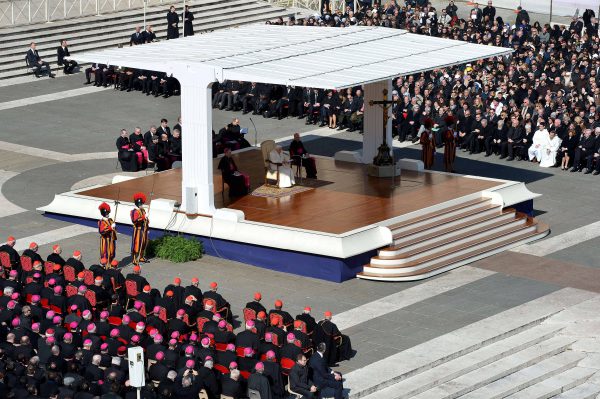 Darunter auch Ehrengäste aus Luxemburg: (v.l.n.r.) Prinz Félix, Erbgroßherzog Guillaume und seine Gemahlin, Prinzessin Stéphanie. Darunter auch Ehrengäste aus Luxemburg: (v.l.n.r.) Prinz Félix, Erbgroßherzog Guillaume und seine Gemahlin, Prinzessin Stéphanie.source: http://www.tageblatt.lu/people/story/Benedikt-wollte-bereits-2012-zuruecktreten-13400774 Papst in Rente _28. Februar 2014 Benedikt wollte bereits 2012 zurücktreten Der emeritierte Papst Benedikt XVI. hat nach Angaben seines früheren Privatsekretärs Georg Gänswein schon 2012 den Entschluss zum Rücktritt gefasst. 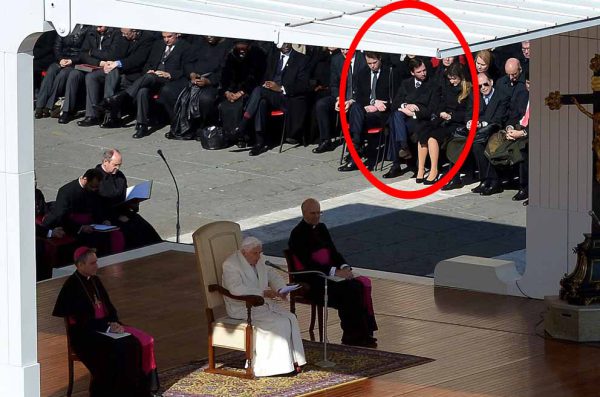 |
|   | | HERVE
Nombre de messages : 21423
Date d'inscription : 08/12/2009
 |  Sujet: Re: Vague d'attentats au Luxembourg Sujet: Re: Vague d'attentats au Luxembourg  Ven 28 Fév 2014 - 11:35 Ven 28 Fév 2014 - 11:35 | |
| La conférence WACL de 1983 à Luxemourg ne semble pas avoir été un succès ... Extrait de "Inside the League" :  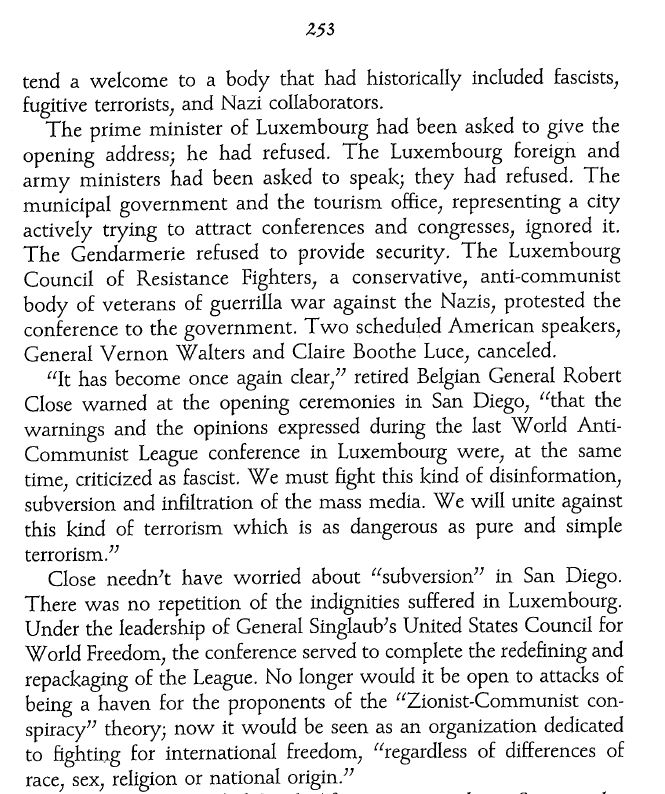 |
|   | | HERVE
Nombre de messages : 21423
Date d'inscription : 08/12/2009
 |  Sujet: Re: Vague d'attentats au Luxembourg Sujet: Re: Vague d'attentats au Luxembourg  Ven 28 Fév 2014 - 12:08 Ven 28 Fév 2014 - 12:08 | |
| Un article sur J. Peter Grace, chez qui le prince Jean a travaillé ...  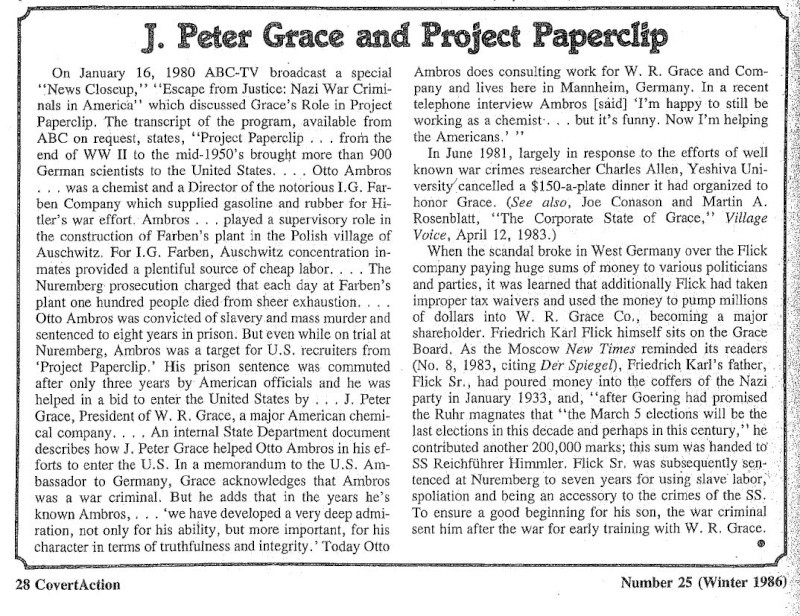 |
|   | | HERVE
Nombre de messages : 21423
Date d'inscription : 08/12/2009
 |  Sujet: Re: Vague d'attentats au Luxembourg Sujet: Re: Vague d'attentats au Luxembourg  Ven 28 Fév 2014 - 12:46 Ven 28 Fév 2014 - 12:46 | |
| Il est aussi question de la famille Grace dans le document audio suivant (Youtube) : 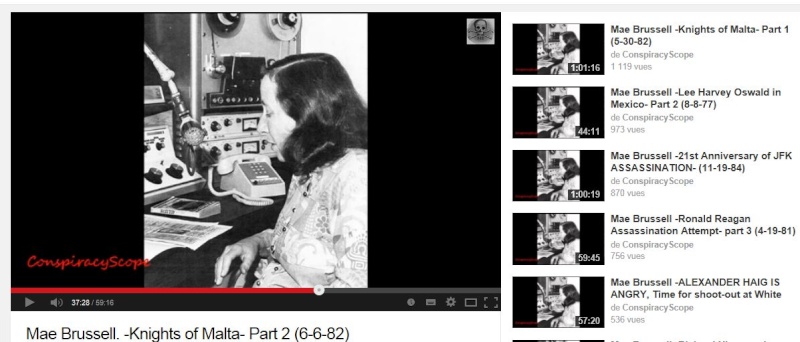 Mae Brussell mentionne le livre "The Nazis go underground" (Curt Riess, 1944) : http://www.spitfirelist.com/books/undergrnd.pdf Extrait des pages 119 et 120 : 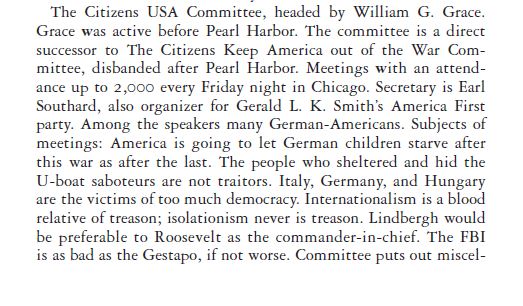 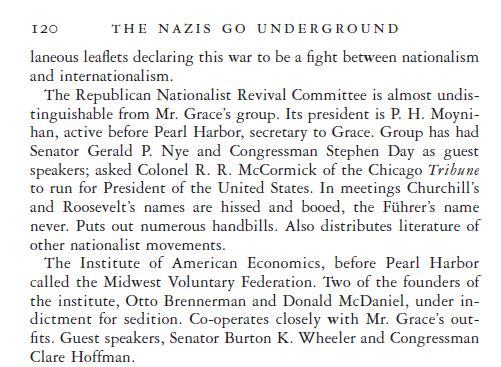 |
|   | | HERVE
Nombre de messages : 21423
Date d'inscription : 08/12/2009
 | |   | | HERVE
Nombre de messages : 21423
Date d'inscription : 08/12/2009
 |  Sujet: Re: Vague d'attentats au Luxembourg Sujet: Re: Vague d'attentats au Luxembourg  Ven 28 Fév 2014 - 13:19 Ven 28 Fév 2014 - 13:19 | |
| On peut ajouter ce qui suit : http://fr.scribd.com/doc/78861418/Hoe-Prins-Alexander-de-Kost-Verdiende  ainsi que, dans les documents signés par Libert : https://tueriesdubrabant.1fr1.net/t1974-pv-1184-9-avril-1986Annexe du 16 avril 1986 : ... une affirmation claire sur les dirigeants de VW Belgique et ceux de Mercedes Belgique...  |
|   | | HERVE
Nombre de messages : 21423
Date d'inscription : 08/12/2009
 |  Sujet: Re: Vague d'attentats au Luxembourg Sujet: Re: Vague d'attentats au Luxembourg  Ven 28 Fév 2014 - 13:52 Ven 28 Fév 2014 - 13:52 | |
|
http://www.lequotidien.lu/bommeleer/53687.html
Les princes ripostent
2014-02-28 08:59:00
Le Prince Jean déclare avoir renoncé de son propre chef à ses droits de succession au trône. La veille de l'attentat contre le Findel, il se trouvait à Paris.
De notre journaliste
Fabienne Armborst
Après l'ancien Premier ministre Jean-Claude Juncker mardi, ce sont les princes Guillaume et Jean qui ont attiré beaucoup de monde, hier, lors de la 139e séance du procès Bommeleeër. Le Prince Jean parle de rumeurs infondées sur sa personne. La veille de l'attentat contre le Findel le 9 novembre 1985, il se trouvait à Paris.
Le 26 septembre 1986, soit quatre mois après le dernier attentat, le Prince Jean renonce à ses droits de succession au trône. Dès lors, une rumeur disant que le souverain aurait un lien avec l'affaire des bombes court. En 1987, le juge d'instruction de l'époque, Prosper Klein, organise une conférence de presse afin de laver le nom des Nassau. Le maréchal de la Cour convoque également le chef de la gendarmerie et un officier au sujet de cette rumeur.
Appelé à la barre hier après-midi, le Prince Jean, a déclaré avoir appris en 2005 seulement, par son frère le Grand-Duc Henri, qu'il était soupçonné d'avoir participé aux attentats. Auparavant, il n'aurait jamais rien entendu à ce propos. «Je n'ai pas été informé, explique-t-il. La personne concernée, la dernière informée.» Cette nouvelle aurait été un véritable choc pour lui.
La présidente de la chambre criminelle, Sylvie Conter, a enchaîné en évoquant le week-end de l'attentat contre le Findel (9 novembre 1985). Le témoin Eugène Beffort a déclaré avoir vu le Prince Jean aux abords du Findel quelques heures avant l'attentat. Le Prince Jean se souvient être allé à Paris, chez sa compagne, le 8 novembre. En fin d'après-midi, il aurait quitté la capitale pour rejoindre la résidence de la famille Giscard d'Estaing dans le département du Loir-et-Cher (France) pour participer à une chasse. Le 9 novembre après le dîner, il serait revenu à Paris.
C'est également ce qu'Hélène Vestur – séparée du Prince depuis – a confirmé hier à la barre. À partir d'une lettre datée du 11 novembre 1985, elle a retracé la partie du week-end qu'ils avaient passée ensemble. «Dans cette lettre, je suis fâchée, car il était resté pour dîner au domaine», a-t-elle commenté. Hélène Vestur a également souligné avoir pris connaissance en 2005 avec stupéfaction de la rumeur concernant le Prince Jean.
Or, ces déclarations ne concordent pas avec la preuve fournie par la Cour. Dans son attestation, Henri Giscard d'Estaing, le fils de l'ancien président de la République française, évoque les dates du 9 et du 10 novembre.
Le Prince Guillaume sans souvenirs
Interrogé par Me Gaston Vogel au sujet de sa renonciation à ses droits de succession au trône quatre mois après le dernier attentat, le Prince Jean a déclaré : «Ce n'est pas mon père (NDLR : le Grand-Duc Jean) qui m'a demandé de renoncer.» Il a expliqué que pour rester dans l'ordre de succession, le chef de famille doit accepter le mariage. Mais le Grand-Duc Jean n'avait pas consenti au mariage de son fils avec Hélène Vestur. La futur femme du Prince à l'époque, une non aristocrate, attendait un enfant mais n'avait encore jamais été présentée à la famille.
Le Prince Jean a donc expliqué avoir renoncé de son propre chef à ses droits de succession : «Cela me laissait la liberté d'entreprendre ma vie.» Il a clarifié par ailleurs qu'il n'a jamais perdu son titre. La renonciation, quant à elle, est toujours «juste».
Le Prince Jean a déclaré ne pas détenir d'information pour l'enquête. Dans une dernière déclaration personnelle, il a exprimé son regret d'avoir été accusé à tort, parce que quelqu'un pense l'avoir vu au Findel. Cela ne serait pas non plus agréable de figurer depuis des années dans la presse pour cette affaire. La présidente a précisé qu'il n'avait pas été accusé. Mais d'après le témoin, dans l'opinion publique, tel serait le cas.
L'audition du Prince Guillaume a été très courte. Il a rappelé qu'en 2000, il a eu un grave accident, suite à quoi ses souvenirs sont devenus très flous. Il ne se rappellerait ainsi par exemple plus son mariage. À la question posée par la défense de savoir s'il a participé à un attentat, le Prince Guillaume a répondu par la négative.
Le procès se poursuit mardi. Le programme de la 140e séance n'est pas encore connu.
|
|   | | VictoryII
Nombre de messages : 103
Date d'inscription : 09/04/2013
 |  Sujet: Quelque chose cloche Sujet: Quelque chose cloche  Ven 28 Fév 2014 - 14:18 Ven 28 Fév 2014 - 14:18 | |
| http://articles.chicagotribune.com/1991-12-16/business/9104230128_1_head-of-commercial-banking-first-american-bankshares-booz-allen-hamilton
http://fr.scribd.com/doc/176081346/THE-BCCI-DOCS
Dernière édition par VictoryII le Ven 28 Fév 2014 - 15:25, édité 1 fois |
|   | | HERVE
Nombre de messages : 21423
Date d'inscription : 08/12/2009
 |  Sujet: Re: Vague d'attentats au Luxembourg Sujet: Re: Vague d'attentats au Luxembourg  Ven 28 Fév 2014 - 14:49 Ven 28 Fév 2014 - 14:49 | |
|
Début 1987, le prince Jean rejoint le cabinet américain de conseil en stratégie Booz Allen Hamilton, où il se spécialise dans le secteur financier.
A la fin de 1991, Booz Allen & Hamilton s'associe à Henry Kissinger.
C'est en effet une information importante.
En outre, il y a un lien avec "The Carlyle Group" et Edward Snowden travaillait pour Booz Allen qui travaillait pour la NSA ...
Le monde est petit ...
|
|   | | HERVE
Nombre de messages : 21423
Date d'inscription : 08/12/2009
 |  Sujet: Re: Vague d'attentats au Luxembourg Sujet: Re: Vague d'attentats au Luxembourg  Ven 28 Fév 2014 - 15:32 Ven 28 Fév 2014 - 15:32 | |
|
L'actuel Directeur du renseignement national des États-Unis, James R. Clapper Jr., est un ancien cadre de Booz Allen.
Quant à celui qui occupait ce poste sous la présidence Bush, John M. McConnell, il travaille maintenant pour Booz Allen.
|
|   | | HERVE
Nombre de messages : 21423
Date d'inscription : 08/12/2009
 |  Sujet: Re: Vague d'attentats au Luxembourg Sujet: Re: Vague d'attentats au Luxembourg  Ven 28 Fév 2014 - 15:55 Ven 28 Fév 2014 - 15:55 | |
| Un long article : http://www.businessweek.com/articles/2013-06-20/booz-allen-the-worlds-most-profitable-spy-organization Booz Allen, the World's Most Profitable Spy Organization By Drake Bennett and Michael Riley June 20, 2013 (...) In a 2003 speech, Joan Dempsey, a former CIA deputy director, referred to Booz Allen as the “shadow IC” (for intelligence community) because of the profusion of “former secretaries of this and directors of that,” according to a 2008 book, Spies for Hire: The Secret World of Intelligence Outsourcing. Today Dempsey works for Booz Allen.  |
|   | | HERVE
Nombre de messages : 21423
Date d'inscription : 08/12/2009
 |  Sujet: Re: Vague d'attentats au Luxembourg Sujet: Re: Vague d'attentats au Luxembourg  Ven 28 Fév 2014 - 16:01 Ven 28 Fév 2014 - 16:01 | |
| Voir aussi : http://www.motherjones.com/politics/2005/01/spy-who-billed-me The Spy Who Billed Me In the post-9/11 rush to beef up intelligence, the government has outsourced everything from spy satellites to covert operations -- and well-connected companies are cashing in. —By Tim Shorrock | January/February 2005 Issue (...) Today, the ties between intelligence agencies and the private sector are so close, it’s sometimes hard to tell the difference. Joan Dempsey, a former CIA deputy director, recently -- and approvingly -- referred to consulting firm Booz Allen as “the shadow intelligence community.” Three of Booz Allen’s current and former vice presidents previously served as intelligence agency directors, including James Woolsey, who headed the CIA during the Clinton administration. Connections with the private sector are especially close at the NSA, where outsourcing has grown rapidly. Former NSA director William Studeman is now a vice president of Northrop Grumman, and Barbara McNamara, a former deputy director, is on the board of CACI. After leaving government, these officials keep their high-level security clearances, which makes them extremely valuable to their new employers. “You can’t do anybusiness without having the clearances,” says John Pike of GlobalSecurity.org, a Virginia- based think tank. “How else would you know about the contracts?” (...) ------- https://tueriesdubrabant.1fr1.net/viewtopic.forum?t=2619 |
|   | | Contenu sponsorisé
 |  Sujet: Re: Vague d'attentats au Luxembourg Sujet: Re: Vague d'attentats au Luxembourg  | |
| |
|   | | | | Vague d'attentats au Luxembourg |  |
|
Sujets similaires |  |
|
| | Permission de ce forum: | Vous ne pouvez pas répondre aux sujets dans ce forum
| |
| |
| |
